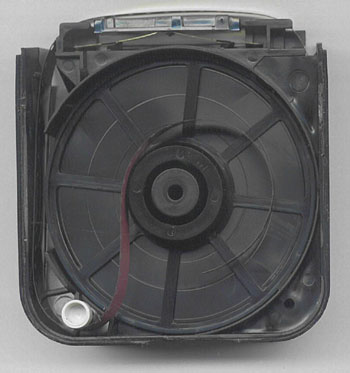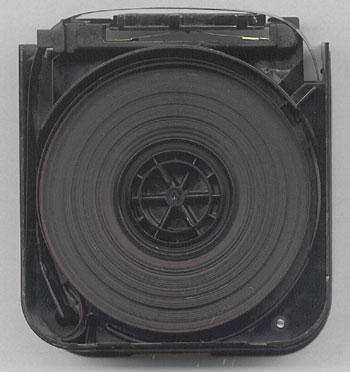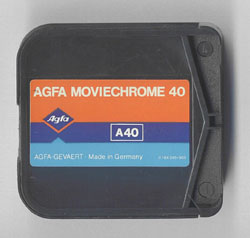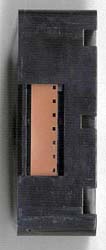Inside a Super 8 Cartridge |
|
| The design of the super 8 cartridge is a very cunning bit of engineering, perhaps a little too clever for its own good... | |
| First a little background: The thing was,
that up to the introduction of Super 8, shooting 8mm was a bit of a fiddle
for the average user. Although the film ended up as 8mm, it was in fact
run through the camera as 16mm film with perforations down both edges.
This was supplied on small cores with a sacrificial length of film to act
as leader whilst threading through the mechanism of the gate and pressure
plate etc. In the case of most small cameras the film was limited to a
length of 25 feet. At the end of the first pass, the film was then flipped
over and run though again, exposing images down the other side of the
strip. After processing, the lab would slit the film lengthways and splice
it end to end. Voila, Standard 8, or just 8mm as it was back then.
In 1965, Kodak introduced the marvel that was the Super 8 system. Cartridges loaded with 50 foot lengths of 8mm film stock. The cartridge used a side by side chamber system and film was wound from one coil to another with no need to lace or flip, just pop it in and shoot... |
|
|
|
|
| The cartridge also features a number of notches (up to 4 in fact) which are used to calibrate the cameras exposure settings, the colour correction filter setting, whether or not the film was sound type and also settings for the labs processing machine. All this made for a fairly fool-proof system and led to the widespread uptake of Super 8 equipment in many households. To this day, Super 8 is a true marvel of ingenuity and despite the lack of major corporations involved (Kodak aside) has potential beyond the perceived view of an out-dated medium. | |
 |
Some users of narrow gauge film are frustrated by the inherent limitations of the cartridge system. The running time of 50 feet of film is fairly short and though for some time, 200 foot cartridges that could be used in certain cameras such as the Nizo 6080 were available, these have now been discontinued. It is also not possible to achieve certain "in camera" effects with much success. The most common one of these is known as "back-winding" and is used for double exposures and dissolves. The cartridge does allow a limited amount of back-wind, but as only the take-up spool is driven, it's only possible to wind back a small quantity (about 90 frames if I remember correctly) of film that is then "stuffed" back into it. This means that it is never wise to attempt dissolves or reverse filming at the beginning of a cartridge! |
| I find the length of a cartridge acts as a "sharpener" for your eye and makes for concise shots and leads to better attention from the viewer of the results! My technique (if I should be so grand!!!) is to have several cameras "on the go" for different projects, collecting material as occasions crop up and keeping themes on separate reels. A set of constraints can be turned into creative benefits depending on your outlook! |  |



